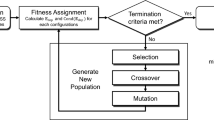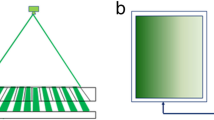Abstract
Arrays of high-density microcalorimeters require careful heat sinking in order to minimize the thermal crosstalk between nearby pixels. For the array of microcalorimeters developed for the Athena X-ray Integral Field Unit instrument, which has more than 3000 pixels on a 275 µm pitch, it is essential to address this problem in order to meet the energy-resolution requirements. The instrument’s energy-resolution budget requires that the impact of the thermal crosstalk on the energy resolution be a contribution that, added in quadrature to other energy-resolution contributions, is less than 0.2 eV. This value results in a derived requirement that the ratio between the amplitude of the crosstalk signal to an X-ray pulse (for example at 6 keV) is less than 1 × 10−3 (for the first neighbor), less than 4 × 10−4 (for the diagonal neighbor) and less than 8 × 10−5 (for the second nearest neighbor). We have measured the thermal crosstalk levels between pixels in various geometries and configurations. The results show a crosstalk ratio which is at least a factor of 4 lower than the derived requirement. We also developed a finite element (FEM) 2D thermal model to predict the thermal behavior of large-scale arrays. This model successfully simulates the measured data in terms of pulse amplitude and time constants.






Similar content being viewed by others
References
K. Nandra et al. (2013) arXiv:1306.2307 [astro-ph.HE]
D. Barret et al., Proceedings, SPIE Space Telescopes and Instrumentation 2014: Ultraviolet to Gamma Ray, vol. 9905, p. 99052F (2016). https://doi.org/10.1117/12.2232432
N. Iyomoto et al., IEEE Trans. Appl. Superconduct. 19(3), 557–560 (2009). https://doi.org/10.1109/TASC.2009.2017704
K. Sakai et al., Pixel optimization of Mo/Au bilayer transition-edge sensors for AC-biased readout. J. Low Temp. Phys. This special issue LTD18 (2019)
N. Iyomoto et al., J. Low Temp. Phys. 151(1–2), 506 (2008). https://doi.org/10.1007/s10909-007-9682-5
C. Kilbourne et al., Proceedings, SPIE Space Telescopes and Instrumentation 2008: Ultraviolet to Gamma Ray, vol. 7011, p. 701104 (2008). https://doi.org/10.1117/12.790027
K.D. Irwin et al., Appl. Phys. Lett. 69, 1945 (1996). https://doi.org/10.1063/1.117630
T. Saab et al., Nucl. Instrum. Methods Phys. Res. A 559, 712 (2006). https://doi.org/10.1016/j.nima.2005.12.112
COMSOL Multiphysics, v. 5.4. www.comsol.com, COMSOL AB, Stockholm, Sweden
Author information
Authors and Affiliations
Corresponding author
Additional information
Publisher's Note
Springer Nature remains neutral with regard to jurisdictional claims in published maps and institutional affiliations.
Rights and permissions
About this article
Cite this article
Miniussi, A.R., Adams, J.S., Bandler, S.R. et al. Thermal Crosstalk Measurements and Simulations for an X-ray Microcalorimeter Array. J Low Temp Phys 199, 663–671 (2020). https://doi.org/10.1007/s10909-019-02312-5
Received:
Accepted:
Published:
Issue Date:
DOI: https://doi.org/10.1007/s10909-019-02312-5




